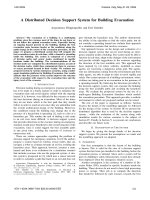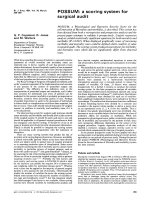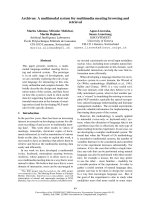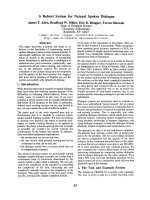The FALCON method a proven system for building passive income and wealth through stock investing
Bạn đang xem bản rút gọn của tài liệu. Xem và tải ngay bản đầy đủ của tài liệu tại đây (2.45 MB, 79 trang )
THE FALCON METHOD
A PROVEN SYSTEM FOR BUILDING PASSIVE INCOME AND WEALTH THROUGH STOCK INVESTING
DAVID SOLYOMI
Copyright © 2017 by David Solyomi. All Rights Reserved.
No part of this book may be reproduced, stored in retrieval systems, or transmitted by any means, electronic, mechanical, photocopying,
recorded or otherwise without written permission from the author.
Published by TCK Publishing
www.TCKPublishing.com
Get discounts and special deals on our bestselling books at
www.tckpublishing.com/bookdeals
Disclaimer
Limit of Liability and Disclaimer of Warranty: While the publisher and author have used their best
efforts in preparing this book, they make no representations or warranties with respect to the accuracy
or completeness of the contents of this book and specifically disclaim any implied merchantability or
fitness for a particular purpose. The advice and strategies contained herein may not be suitable for
your situation. You should consult with a professional where appropriate. Neither the publisher nor
author shall be liable for any loss of profit or any other commercial damages, including but not
limited to special, incidental, consequential, or other damages.
Table of Contents
Preface
The True Story Behind the FALCON Method
Why Stocks? (For The Long Run)
The Black Box
The Goal of the FALCON Method
Outlining the Process of the FALCON Method
A Select Group of Top-Quality Companies
Double-Dip Benefit: Buy Them on the Cheap!
Threshold Criteria: Should You Open Your Wallet at All?
Rank the Survivors
Final Round: Enter the Human
How Can the FALCON Method Help You?
The Price: How Much Can You Save?
How to Use the Newsletter Wisely
Recap: Dissecting the “Black Box Model”
About the Author
Endnotes
Why This Book?
If you are like me, you have probably run across several trading and investment approaches that
promised to make you rich but failed to live up to those expectations. But within just a few pages,
you’ll realize that this book and the FALCON Method it describes are completely different and can
truly set you on the path to becoming a successful long-term investor regardless of your current
experience level. After years of learning from hundreds of investment books and my own mistakes, I
find myself wishing I’d had the chance to read such a concise summary of all the important aspects of
investing wisely before I had set sail into money management.
No matter how you ended up here, this book will show you:
Why you absolutely must invest in stocks if you are aiming to build wealth and a
predictable passive income stream.
How you should reduce the universe of stocks from tens of thousands of possibilities to a
few hundred candidates that have the characteristics that are proven to drive superior
performance.
How to tell which of these top-quality stocks are available on the cheap, thus offering a
turbo-boost to your returns (AKA the double-dip benefit).
What absolute threshold criteria you should set before putting your money into any
investment.
How to rank the stocks that seem to have it all: both top quality and attractive valuation.
What other aspects to examine before committing your capital to a promising investment
candidate.
And last but not least: how to make the most of an investment approach—the FALCON
Method—that gives you a list of the best stocks every month. Knowing the names of the
Top10 stocks is not everything, believe me!
Successful investing requires structured decision-making based on a well-built process—and this
is exactly what you will learn in this book. In fact, you can get a glimpse of the FALCON Method
flowchart after the Foreword and see for yourself what steps it utilizes to achieve superior
performance. (In the following chapters, you will get to know all of them one by one.)
I want to emphasize that I am the type of guy who is most definitely putting his money where his mouth
is, so I am managing my own investments based on the approach covered in this book, following
the exact same process. In fact, I have built the FALCON Method from scratch—it took years of
gradual improvements and fine-tuning to reach the standard you are about to learn here. As a
wonderful side effect, I achieved financial freedom along the way at the age of just 33, proving that
this process really works!
You can get to know my personal story in detail in the About the Author chapter, which was confined
to the end of the book. At this point, suffice it to say that I’ve established and sold some companies,
so I gathered plenty of experience as both a corporate insider and an outside investor. I completely
agree with Warren Buffett that being a businessman does help one to become a better investor and
vice versa.
After surrendering all my executive roles, I became a full-time investor. I wrote a best-selling book
on dividend investing in Hungary, where I live, and shared my knowledge in both personal and
online training formats while also taking up speaking engagements at financial conferences. I enjoy
what I am doing—investing is my passion and this will show through on the following pages, where I
have spiced up the useful content with a little bit of humor to make your learning adventure fun and
easy.
Don’t fear—investment doesn’t have to be daunting. You will surely be able to grasp and use
what I am about to share with you because I packaged it into a simple and easy-to-digest format.
I’m not the kind of person who uses jargon just to showcase his financial education. And because I’m
already living off passive income, I am not even writing this book with a definite financial motivation
or in search of sales—instead, I wrote it to help you start along the same path that made achieving my
childhood dreams possible. You don’t even need to become a full-time investor like me— a few
hours per month should be more than enough to profit immensely from what you will learn here.
Let me walk you through all you should know to get outstanding results as a long-term investor, using
100% honesty and a little bit of humor so that we both enjoy the journey. And before we move on, as
an extra guarantee for your time invested, I am offering you my personal help when you start out as an
investor. Now you have plenty of reasons to read on!
Preface
What Makes a Good Company and a Good Investment?
The value of an investment is determined by the amount of cash it can pay you, the timing and
probability of these payments, and the prevailing risk-free interest rate. If this sounds complex, it’s
not, really: let me show you how sensible investing can be simple and rewarding at the same time.
History shows us that stocks provide the best returns in the long run. Since stocks are not lottery
tickets but rather represent ownership stakes in real companies, there are just two questions a
successful investor must be able to answer:
What makes a good company?
A firm that produces more cash than it consumes and only needs to retain a fraction of this surplus
cash to maintain the standard of its operations and its competitiveness can be a promising candidate
for investment. The key is having this “no-strings-attached cash,” which can either serve as the source
of further growth or can be returned to the owners.
To understand the importance of this “no-strings-attached cash,” think about a company that needs to
invest all the cash it makes just to stay competitive and be able to make the exact same amount of cash
the next year—which, of course, needs to be retained again just for the sake of survival. As an owner
of this company, your chances of receiving cash back from your investment are very slim; this alone
renders such a company an unattractive target for investment.
The essence of a company’s operations can be grasped by following the “no-strings-attached cash” it
generates and the return it makes on the capital employed. The company’s management must be
capable of achieving a rate of return on the company’s invested capital that is superior to what you
could get as a private investor. Otherwise, why keep your money in the firm? This both sounds simple
and is fairly straightforward to gauge, too.
So a good company produces tons of surplus cash and earns high rates of return on its invested
capital. It’s a great thing if the corporate operations look splendid, but all that glitters is not gold.
Making loads of cash is just one part of the story—what the management does with this money is
equally important.
This is where capital allocation skills come into play. You want to be the owner of a company that
not only makes a huge amount of the attractive “no-strings-attached cash” category, but uses it wisely
as well…and treats its shareholders fairly, too. Otherwise, it would be like printing cash in one room
just to burn it in another.
What makes a good investment?
As we’ve seen, a good company excels in the operations and capital allocation dimensions. But these
alone will not make it a good investment, since the company will give you subpar returns if you
overpay for the shares. This is where the third key dimension, valuation, comes into play. You need to
buy stocks of quality companies when they are available on the cheap—that’s the recipe for stock
market success and wealth building. As obvious as it sounds, this has been proven to work for
centuries, as we will soon see.
You either have a process or you are just gambling.
“When somebody calls, I can usually tell within two or three minutes whether a deal is likely to
happen or not. There are just half a dozen filters, and it either makes through the filters or not.”
—Warren Buffett in a Bloomberg video interview, 2016
Identifying the quality stocks that are on sale can be easy if you have a well-built process to help you.
It is like having a machine with an input slot and an output slot: 300 stocks go in and the 10 best come
out. This is exactly what the FALCON Method is doing, relying on the principles of value investing,
common sense, and quantitative discipline.
You can get a grasp of the underlying process by studying the flowchart in the following chapter.
However, to gain a really good understanding, you should read the entire book. By the end, you will
have become a better investor. Then you have a choice: I can help you implement what you have
learned or you can continue your journey alone. No matter which route you choose, you will benefit
immensely from learning the all-round investment approach of the FALCON Method.
Flowchart of the FALCON Method
The True Story Behind the FALCON Method
Let me prepare you for the honesty you will encounter in this book with a short story. Any marketing
guy would advise against admitting the true origin of the system’s name, but I will go with my gut and
share the real behind-the-scenes story.
Tons of fake origin stories could be fabricated, listing similarities between the falcon and a good
investor. Here are a few, just for pure entertainment:
Nothing can hide from the eyes of the falcon. Wikipedia says: “As is the case with many
birds of prey, falcons have exceptional powers of vision; the visual acuity of one species has
been measured at 2.6 times that of a normal human.” How profitable could it be if an
investor noticed opportunities that others miss, while objectively scanning the field of targets
from the distance without any emotional biases? But come on, this has nothing to do with the
origin of the name, however convincing it may sound!
Falcons never hesitate; whenever they see a delicious bite, they go for it. And fast!
“Peregrine falcons have been recorded diving at speeds of 200 miles per hour (320 km/h),
making them the fastest-moving creatures on Earth.” This was from Wikipedia again, as I
hardly know anything about falcons myself. Once again, this was absolutely not the reason
for picking the name FALCON Method.
Falcons have exceptional hunting skills… Well, instead of elaborating on this obvious
parallelism, I feel it is time for my confession.
In 2016, I had a meeting with a person who was, in fact, a marketing guy. He offered me his opinion
about how I could reach a wider audience with my best-selling Hungarian book on dividend investing
and its related online courses. At one point, he just stared at me and out of the blue, said: “You should
write your book and create your courses in English, but as there are thousands of books on dividend
investing on Amazon, you need a brand to stand out from the crowd. I would call it the FALCON
Method or something like that.”
Well, my family name means “falcon” if translated to English, but I honestly do not know how this
idea came to him. As ridiculous as it sounded, I simply ignored his comment. I created a short video
course in English, but of course didn’t brand it the “FALCON Method.” While that course was
available on popular e-learning platforms, I registered the domain of my name (davidsolyomi.com)
and started experimenting with building a WordPress site without any specific purpose. I named one
of the menus “The FALCON Method” and created a dropdown menu with two options: “FREE
videos” and “FULL video training.” (This was the biggest achievement of my site-building career.)
As I gained hundreds of students on the e-learning platforms and my dividend investing course
became a bestseller, strange emails started to flow in. It seemed that after watching my videos,
people were Googling my name and found that the site was “under construction,” to put it mildly.
They started to contact me, asking questions about where the FALCON Method mentioned on the site
was available because they most definitely wanted to purchase it.
I had a good laugh when reading the first such email. The second one made me think a little bit, while
the third one almost made me admit that the marketing guy might be a true genius. (I would never, ever
tell him that, so I hope he is not reading this!) And as these emails continued, I strongly felt that I
should not hold the falcon captive any longer: I should let it fly if the demand was that high.
This is the true reason for choosing the name FALCON Method for the most all-round investment
approach I am aware of and that you are about to learn in the following pages. I hope you’ll enjoy this
same kind of honesty and a bit of humor throughout the book, because I believe it’ll make our journey
together more useful and fun.
Why Stocks? (For The Long Run)
“Investing is forgoing consumption now in order to have the ability to consume more at a later
date.”
—Warren Buffett, 2011
Before getting into the details of stock selection and showing you how my system works, I want you to
be 100% convinced that stocks are the absolute best asset class to invest in if you are aiming to build
wealth and generate reliable income in the long term.
Having experienced violent swings in the stock market myself, I am sure that understanding the
investment concept you are about to employ and being totally committed to following it is crucial; it
will serve as the basis of outstanding results. Without this part, you are likely to give up executing the
strategy at the worst possible moment, doing serious harm to your financial future. So, let’s lay down
those basics as quickly and effectively as possible.
Warren Buffett, one of the world’s most successful investors, draws up three major investment
categories in his 2011 Letter to Shareholders:
“Investment possibilities are both many and varied. There are three major categories, however,
and it’s important to understand the characteristics of each.
1. Investments that are denominated in a given currency include money-market funds, bonds,
mortgages, bank deposits, and other instruments. Most of these currency-based investments are
thought of as ‘safe.’ In truth, they are among the most dangerous of assets. Over the past century,
these instruments have destroyed the purchasing power of investors in many countries, even as the
holders continued to receive timely payments of interest and principal. This ugly result, moreover,
will forever recur. Governments determine the ultimate value of money, and systemic forces will
sometimes cause them to gravitate to policies that produce inflation. Current rates, however, do
not come close to offsetting the purchasing-power risk that investors assume. Right now, bonds
should come with a warning label. Today, a wry comment that Wall Streeter Shelby Cullom Davis
made long ago seems apt: ‘Bonds promoted as offering risk-free returns are now priced to deliver
return-free risk.’”
To sum up, the first category of fixed-income type investments gives you just what it advertises: a
fixed income component. The problem is, nobody knows what that future sum (interests and the return
of your principal) will be worth at the time you’re entitled to get it. By investing in fixed-income
products, you are basically speculating on the future rate of inflation, and such macroeconomic
speculation seldom turns out to be successful[1]. With some investments in this first category, you can
spare yourself the agony of price fluctuations (AKA volatility), although in return for the tranquility,
you will slowly but surely lose your purchasing power[2]. Assuming this is not your goal, let’s move
on!
“2.The second major category of investments involves assets that will never produce anything, but
that are purchased in the buyer’s hope that someone else—who also knows that the assets will be
forever unproductive—will pay more for them in the future.
Owners are not inspired by what the asset itself can produce—it will remain lifeless forever—but
rather by the belief that others will desire it even more avidly in the future.”
This second category is all about speculation and has nothing to do with investing. Buffett brings up
the example of gold, which never produces anything, so anyone purchasing it is basically hoping that
someday fear will motivate a larger group of people to buy gold, thus driving up its price. If you are
buying unproductive assets, you are waiting for a bigger fool to come along and pay more for them
than you did—and if that person fails to show up, you are the one left holding the bag. Speculation is
not something you should build your financial future on.
Assuming you agree, let’s see what Warren Buffett advocates! His reasoning is crystal clear, as usual.
“3. My own preference—and you knew this was coming—is our third category: investment in
productive assets, whether businesses, farms, or real estate. Ideally, these assets should have the
ability in inflationary times to deliver output that will retain its purchasing-power value while
requiring a minimum of new capital investment.
Whether the currency a century from now is based on gold, seashells, shark teeth, or a piece of
paper (as today), people will be willing to exchange a couple of minutes of their daily labor for a
Coca-Cola
Our country’s businesses will continue to efficiently deliver goods and services wanted by our
citizens. Metaphorically, these commercial “cows” will live for centuries and give ever greater
quantities of “milk” to boot. Their value will be determined not by the medium of exchange but
rather by their capacity to deliver milk.
I believe that over any extended period of time, this category of investing will prove to be the
runaway winner among the three we’ve examined. More important, it will be by far the safest.”
What shall I add? Buffett is right: investing in productive assets like buying partial ownership stakes
in quality companies in the form of shares is the “runaway winner” in the long run. Before I call on
Professor Jeremy Siegel from Wharton to back up Buffett’s statements with some data, I feel I need to
clear up the meaning of the last sentence in the above quotation. By calling them “the safest,” Warren
Buffett means that the assets within this third category have the greatest probability of preserving and
growing your purchasing power. Risk is the probability of permanent capital loss and has nothing
to do with the price fluctuations of various investments. This is where most people go wrong: they
chase bonds because of their illusory safety (low volatility) while avoiding stocks because their
prices fluctuate. That’s the opposite of what you should be doing, though!
Let’s see why you shouldn’t fear stocks and why you absolutely must invest in them if you are gunning
for the best financial future possible.
“How many millionaires do you know who have become wealthy by investing in savings
accounts?”
—Robert G. Allen
Professor Siegel’s widely referenced book, Stocks for the Long Run, contains an invaluable set of
data to draw conclusions from. In the fifth edition, he examined asset returns from 1802 to 2012 and
compiled the chart below to showcase his findings.
These are real returns, reflecting the effect of inflation and showing how your future purchasing
power could vary based on the investment asset you pick. Stocks are way off the chart, while
hoarding cash is the worst possible thing you can do.(Note that investing $1 in the stock market
multiplied your purchasing power by almost 705,000 between 1802 and 2012, while the second best
asset only had a multiple of 1,778. A huge gap indeed!)
“By a continuing process of inflation, governments can confiscate, secretly and unobserved, an
important part of the wealth of their citizens.
The process engages all the hidden forces of economic law on the side of destruction, and does
it in a manner which not one man in a million is able to diagnose.”
—John Maynard Keynes
Are you serious about building wealth? Stocks are the vehicle you need to use, as centuries of data
and the insights from the most reputable and accomplished investors in the world show. Accepting
this fact is the first crucial step toward success.
Now let’s move on and clear up the mystery that surrounds stocks and the stock market!
The Black Box
“Stocks aren’t lottery tickets. There’s a company attached to every share.”
—Peter Lynch
There is nothing special or hard to understand about stocks. A stock simply represents an ownership
stake in a company. If you buy a share of Coca-Cola, you become an owner of that company and are
entitled to your share of profits. It is as simple as that—although the financial industry doesn’t want
you to get the picture and have the courage to invest on your own, so they deliberately try to
overcomplicate things and use jargon most people don’t understand. After all, they have to make
money somehow, even if they provide a shocking disservice by not being able to invest better than
you could, despite still offering their “help” at a really hefty price[3].
At this point, you must be convinced that you should invest in stocks. You know that with stocks, you
are basically investing in the underlying companies. Now it’s time to take a look at how a company
operates and how it can generate and use cash, since understanding this will be the key to your
financial future. (Don’t be afraid! The solution I draw up with the FALCON Method will free you
from analyzing all the factors one by one, but I still feel you should have a look at them once to get a
better understanding of how everything works under the hood.)
I came across a very illustrative description of how a company operates in David van Knapp’s book
Sensible Stock Investing[4], so I will use his model to highlight all the points that are good to know.
The following picture will simplify things:
First of all, when thinking about a company financially, consider it to be a black box. You must accept
that because you’re an outsider, you have absolutely no chance to know with any certainty what is
happening inside that black box. The good news is that you do not actually need this knowledge to
create a reliable and growing passive income and achieve outstanding total returns from your
investments. Since a company is all about value creation, meaning that it must generate more money
than the amount that went in, you will be perfectly fine focusing on the money pipes connected to the
black box. Let’s see what input pipes can carry money into the box!
The input pipes are:
Revenues: The money the company receives from customers of its products and services.
Borrowed money: The firm can get a bank loan or issue bonds to finance its operations.
The key will be how the management puts this borrowed money to use and what return it
can squeeze out of it.(Hint: it should be way above the interest paid.)
Equity sale: The company can issue new shares, thus diluting its existing shareholders’
stakes. It is extremely important to have a look at this input pipe, because many
companies are funding their dividend payments from this source—which is not desirable,
to put it mildly. (Too many dividend investors don’t pay attention to this and can fall prey
to unfair practices employed by a company’s management.)
“Other companies sell newly issued shares to Peter in order to pay dividends to Paul. Beware
of dividends that can be paid out only if someone promises to replace the capital distributed.”
—Warren Buffett, 1981
The output pipes are the following:
Ongoing expenses: These are about financing the company’s day-to-day operations. This
pipe typically includes salaries, office supplies, marketing and advertising costs, etc.
Capital expenditures: This is money spent on things that have a useful life of more than
one year, like computers, machinery, buildings, etc.
Acquisitions of other companies: One form of growth can be the purchase of other
companies.
Payments on debts: The money that the “borrowed money” income pipe brought into the
black box does not come for free. This output pipe shows how much the company pays
out to service its debt.
Taxes: This is pretty self-explanatory. All companies have to pay their fair share to the
government.
Profits: Intelligent investors keep close tabs on not only the level of profits a company
makes but also the way it uses the surplus cash it generates[5]. The dimension of capital
allocation is just as important as profit generation.
“We, as well as many other businesses, are likely to retain earnings over the next decade that
will equal, or even exceed, the capital we presently employ. Some companies will turn these
retained dollars into fifty-cent pieces, others into two-dollar bills.
“This ‘what-will-they-do-with-the-money’ factor must always be evaluated along with the
‘what-do-we-have-now’ calculation in order for us, or anybody, to arrive at a sensible estimate
of a company’s intrinsic value.”
—Warren Buffett, 2010
Paying attention to Buffett’s words, investors should focus on what a company’s profits are used for.
In the FALCON Method, we surely will! But to get you ready to tackle this key component, let’s have
a look at the three possible uses of profits: the sub-pipes of the “Profits” pipe!
Dividends: The company can pay part of its profits to its shareholders. (Hint:
You will love the money flowing through this pipe!)
Share buyback: When a company spends a certain part of its surplus cash to
purchase its (hopefully undervalued) shares on the open market, it can
decrease the total number of shares that represent the underlying company. As
a result of the decreasing share count, the earnings per share figure grows. To
paraphrase the title of a bestselling book: there are at least “50 shades” of
buybacks, so we will pay attention to this pipe along with share issuances in
order to help us identify value creation and destruction.
Retained earnings: Through this pipe, the company recycles money back into
itself for growth and expansion, so this becomes the fourth input pipe. Again,
the key here will be how efficiently the management can employ this capital.
This is all you need to know to understand how to pick the right companies to invest in—and this was
the toughest part of the book, I promise! You will not need to learn this model by heart, but it is useful
to read it through so that you can gain a better understanding of why the FALCON Method is built the
way it is. You may notice that the investment process I outline below really takes all the important
variables into account and is much more than an oversimplified dividend investing model, of which
you can find dozens, if not hundreds, on the market…most of them with serious flaws. (So serious, in
fact, that after reading just these few brief pages, you’ll be able to uncover some of them!)
To summarize: As an outsider, you should accept that the inner processes of a company will be
hidden from you. Treat the company as a black box and focus on the input and output pipes that are
attached to it! After all, corporate operations are about value creation: generating more money than
the company uses in the process. You can grasp this perfectly by turning your attention to the pipes
transferring the money. Don’t take your eyes off the ball… I mean, money, and you will be fine!
It’s somewhat sad to say, but even if this was your first reading about how a company operates, you
already have a more nuanced understanding of the issue than most investors do.
One more thing before we move on: rest assured that you will not need to analyze these pipes
that I have detailed one by one! The steps of the FALCON Method cover all the critical parts.
Now that you’ve learned the basics here, the rest of this book will be so logical and self-explanatory
that you won’t understand why you aren’t already practicing the ideas I outline!
So let’s see what purposes the FALCON Method serves, and set our goals properly before we get
into the step-by-step process of implementation!
The Goal of the FALCON Method
It’s all about buy and hold! This is not the classic quant model
“All the real money in investment will have to be made—as most of it has been in the past—not
out of buying and selling but out of owning and holding securities, receiving interests and
dividends therein, and benefiting from their long-term increases in value.”
—Benjamin Graham
The FALCON Method is meant to assist you in constructing a “buy and hold” stock portfolio. This is
a far more important distinction than you may think. The classic and popular quant models are backtested with the assumption that you are ranking stocks based on some quantitative criteria and then
buying the best of them (the ones that ranked highest). You are supposed to hold these picks for 12
months, then sell them and repeat the process: do the ranking again and simply buy the stocks that rank
highest at that time[6]. Quant investing means 100% mechanical investing.
Although there are some quantitative factors that are proven to explain outperformance, there are
serious problems with the practical application of the classic quant approach.
First of all, most of these rankings produce a list of stocks featuring totally unknown companies that
are very hard, if not impossible, for most investors to buy from a psychological perspective. (Would
you commit your capital—your hard-earned cash—to something you’d never heard about? Most of us
feel quite uncomfortable with this.)
The annual rebalancing of the portfolio is another issue. Back-tests seldom, if ever, factor in the
transaction costs and tax effects of changing all the stocks in your portfolio every year. Plus, this
practice doesn’t come naturally for most investors. Still, if you sign up for the convincing promises of
a quant model, you should follow its implementation to the letter, however bad it feels. (Otherwise,
you may base your expectations on data that are not relevant for your modified investment process.)
“A portfolio is like a bar of soap: the more you handle it, the smaller it gets.”
—Unknown
The most important shortcoming, however, is that no quant model performs exceptionally well every
single year, so you will have to deal with bad results along the way, all while not being totally
comfortable with the background of your stock selection. (Whichever quant strategy you choose, I bet
you won’t feel good about the “black box background” of the ranking process and the list of stocks it
makes you purchase.) Understanding the logic of the strategy you are implementing and completely
trusting the approach you’re using are crucial to your future success, since you will have to stay the
course in tough times as well as good.
“[Investing in quant models is] hard for people to do, for two main reasons. First, the
companies that show up on the screens can be scary and not doing so well, so people find them
difficult to buy. Second, there can be one-, two- or three-year periods when a strategy doesn't
work. Most people aren't capable of sticking it out through that.”
—Joel Greenblatt
Long story short: when investing, you will probably quickly give up using the classic quant models
for psychological reasons, while you will be capable of sticking with the buy and hold approach of
the FALCON Method. That’s because you’ll understand the process, and the stocks it suggests are
mostly household names. It is easier psychologically to hold stocks in reputable, well-known
companies that are putting more and more money into your pocket in the form of dividends than it is to
buy stocks in unknown small companies and then change all of them when the year ends.
Active stock trading—buying and selling stocks often—is also a field that makes only a small
proportion of adventurers rich. The reasons are numerous: psychological factors, transaction costs,
and taxes, just to name a few.
Buy and hold is the way to go, and gives the best results for most investors.
More than just dividends
The FALCON Method does not employ a pure income-focused strategy. There is much more to stock
investing than the current dividend yield! Although our process embraces a wider scale of factors
than most dividend investors do, we still get the predictable and growing passive income component
by investing in companies that have been paying stable or increasing dividends for decades.
“Do you know the only thing that gives me pleasure? It’s to see my dividends coming in.”
—John D. Rockefeller
Besides focusing on dividends as an important part of our total return, the FALCON Method picks the
list of stocks that are both producing the passive income we love and are available at bargain prices
(that is, they are valued lower than their average historical valuation level). When the natural process
of mean reversion comes into play and the valuation multiple expands, our total return gets a huge
extra boost. (I will explain this in more detail later, illustrating the point with examples.)
In the end, by understanding that a stock’s current dividend yield is only a part of the total return
equation, you get much more than just a reliable and growing passive income. And you get more than
just dividends, since you will be investing in a more sensible way than 95% of the people out there
trying their luck with stocks.
By the end of this book, you will see that on the one hand, dividends are a very important factor in
determining your total return, while on the other hand, stable and growing dividends are the
symptom of a wonderful corporate operation and by no means the cause of it. Anyway, we are
more than happy if such a symptom serves as a telltale sign for us to identify top-quality companies
that have been generating more and more surplus cash for decades and rewarding their shareholders
fairly along the way.
Without a system, you are just gambling
“The rational man—like the Loch Ness monster—is sighted often, but photographed rarely.”
—David Dreman
Most mistakes in investing come from psychological biases. Just imagine what irrational decision
makers we must be when a whole new field of science called behavioral finance is flourishing these
days! None of us can escape the biases we are born with—this is why we need to tackle those mental
hangups in the best possible way, getting past them so we can make smarter choices.
I believe in structured decision-making and the consistent application of a logically built, proven
system. This way, you can tilt the odds of success in your favor before your ego comes into play.
Going by your instincts or investing without a system is all about dumb luck and can promise no
consistent results. Focus on what you can control (the process) and the results will take care of
themselves!
Do you happen to know why so few professional investors manage to beat the S&P 500 index
in the long run? Because the index is totally emotion-free; it just consistently executes a very
simple strategy (like investing in the 500 largest companies) without overthinking or changing
its style, whereas most investors are not capable of staying the course and sticking with their
chosen strategy in the long run. James O’Shaughnessy points this out in his wonderful book
What Works on Wall Street.
The FALCON Method is built to limit psychological errors and emotional decision making. It’s based
on a well-structured process that only leaves room for subjectivity in the later phases, when it is
already too late to make any costly mistakes, since basically all stocks that survive the filtering
process until that last round provide significantly above-average investment opportunities. Although
my ego may feed on the belief that I can add extra value by carrying out some qualitative analysis at
this last stage, this is hard to test (lucky me!),so I would rather overweight the proven factors of
outperformance that are to be detailed on the following pages.
In summary: The FALCON Method is a structured stock selection process that helps to construct a
buy and hold portfolio with a focus on both income and total return. The model is about 90%
quantitative and 10% qualitative.
Putting all these into practice
"In theory, there is no difference between theory and practice. In practice, there is."
—Yogi Berra
Anybody can fill pages with empty sentences about how to invest wisely and what you need to know
to succeed. The difference is in how these lines are implemented after the talking is done.
1. First and foremost, because buy and hold is the best possible investment approach you
can practice, we need to focus on a select group of stocks that are suitable for this
strategy. These are reputable companies that have been making increasing profits and
paying growing dividends for decades. Such pre-filtering of the whole stock universe is
absolutely necessary to help you stay the course in the long run.
2. The FALCON Method will never “sell” you the so-called “deep value trash” stocks that
are cheap if evaluated on certain metrics but otherwise represent terrible companies.
Such a quantitative approach can be rewarding for a small minority of people who are
psychologically prepared to practice it—but when taking taxes and transaction costs into
account, I am not sure that such strategies could significantly outperform the qualityfocused buy and hold approach in the long run.
3. I advocate a SWAN (Sleep Well At Night) style of investing, since you only live once,
and if your investments keep you up at night, you have basically ruined your life. This is
too high a price for any return! If you were able to calculate some totally subjective
indicator of returns that also took your feelings into account, I’m pretty sure that the
investment approach you’re learning here would rank highest.
4. Since you need to stay the course through thick and thin, dividends play an important part
in our model. It is always easier to hold onto (and maybe even buy more of)the stocks of
well-known companies that are paying you growing dividends, even when the stock
market collapses, than to commit yourself to some microcap[7] garbage that’s been spit
out by a semi-reliable stock screener.
5. The power of understanding how the FALCON Method works cannot be
overemphasized. You should never blindly follow anyone who advertises himself as
an extraordinary investor, because this is a sure path to huge losses. I’m not the type
of guy who will hard-sell you anything, be it a single stock pick or my investment
newsletter. I believe in passing on valuable knowledge so that people can have an insight
into what I am doing and why. This way, you can learn and prosper at the same time,
while becoming a much better investor than you may be today.
6. Strong long-term performance always stems from staying the course. Remember the eyeopening example of the S&P 500 index? Consistency pays dividends! All of the previous
points are there to help you stay the course and tilt the odds in your favor.
If you are dedicated to long-term wealth building and the thoughts above are resonating with your
core values, then it’s worth reading on and getting to know the components of the FALCON Method.









